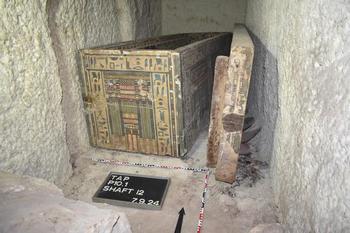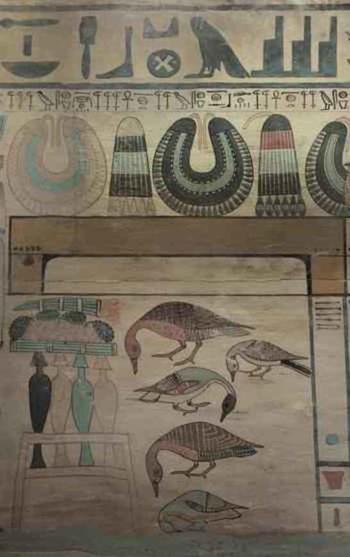Burial chamber of ancient Egyptian lady "Edi" found in Assiut
13.10.2024
Idy's burial chamber
Bildquelle: Susen Döbel, © Jochem Kahl, The Asyut Project
Outer coffin of Edi
Bildquelle: Foto: Susen Döbel, © Jochem Kahl, The Asyut Project.
A joint Egyptian-German archaeological mission has uncovered the burial chamber of a woman named "Edi," the daughter of Jifai-Hapi in Assiut.
From August 18th, 2024 to September 17th, 2024, the 18th excavation campaign of the Institute of Egyptology took place in the necropolis of Assiut (Egypt). The excavations were carried out under the direction of Prof. Dr. Jochem Kahl (Freie Universität Berlin) in cooperation with the University of Sohag (Egypt), Kanazawa University (Japan) and the Polish Academy of Sciences.
Among other things, the excavation and documentation of the tomb of the regional governor Djefai-Hapi I from around 1880 BC was continued. Djefai-Hapi I was deified in ancient times and his tomb was an integral part of the cultural memory of ancient Egypt for more than 2000 years. Djefai-Hapi I was married twice. The international team of scientists was now able to uncover the burial of his only daughter Idy in this tomb after exactly 20 years of field work. Unnoticed by previous researchers, Idy's burial was placed in a side chamber closed off by rubble stones in a vertical shaft about 14 m deep that had been dug in the tomb of Djefai-Hapi I. The uncovering of this shaft began in 2022, took three excavation campaigns and has now ended with a sensational discovery: Idy's burial in two nested wooden coffins with numerous grave goods.
Although Idy's burial had already been robbed of all jewelry and metal objects in ancient times in the search for treasures, all other grave goods seem to have been of no interest to the ancient looters. After this ancient robbery, the shaft and Idy were forgotten. In particular, the wealth of texts - religious texts (so-called coffin texts), lists of sacrifices and titles - will allow new and far-reaching statements to be made about the position of women and the transfer of knowledge in ancient Egypt. Images show objects that were part of the burial ritual. Remnants of Idy's garment and her bones, which were completely torn to shreds by ancient looters, provide information about her personality: According to an initial visual inspection, Idy was probably around 40 years old and suffered from a foot problem.
After an initial conservational consolidation of the wooden objects in the burial chamber and the subsequent complex recovery, the finds will be handed over to the Egyptian Ministry of Antiquities and Tourism.
Read the full article by Univ. Prof. Dr. Jochem kahl (in German).



